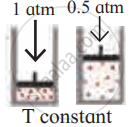Advertisements
Advertisements
प्रश्न
A sample of gas at 15°C at 1 atm. has a volume of 2.58 dm3. When the temperature is raised to 38°C at 1 atm does the volume of the gas Increase? If so, calculate the final volume.
उत्तर
T1 = 15°C + 273
T2 = 38°C + 273
T1 = 228 K
T2 = 311 K
V1 = 2.58 dm3
V2 = ?
(P = 1 atom constant)
`"V"_1/"T"_1 = "V"_2/"T"_2`
V2 = `("V"_1/"T"_1)` × T2
= `(2.58 "dm"^3)/(288 "K") xx 311 "K"`
V2 = 2.78 dm3
i.e, volume increased from 2.58 dm3 to 2.78 dm3
APPEARS IN
संबंधित प्रश्न
Convert the following temperature from degree Celcius to kelvin.
273° C
Convert the following pressure value into Pascals.
1 kPa
Convert −100° C to kelvin
Identify the gas laws from the following diagram.
| Diagram | Gas laws |
 |
______________ |
Consider a sample of a gas in a cylinder with a movable piston.

Show diagrammatically the changes in the position of the piston, if the temperature is decreased from 400 K to 300 K, and pressure is decreased from 4 bar to 3 bar.
With the help of the graph answer the following -

At constant temperature, Identify the law.
Solve the following.
The volume of a given mass of a gas at 0°C is 2 dm3. Calculate the new volume of the gas at constant pressure when the temperature is increased by 10°C.
State Boyle's law.
Name two items that can serve as a model for Gay Lusaac’s law and explain.
At what temperature, the volume of gas would become zero?
